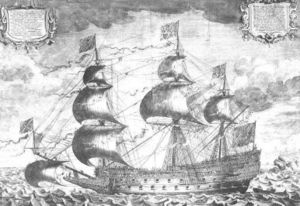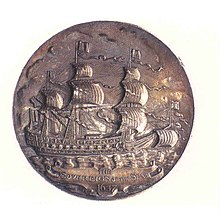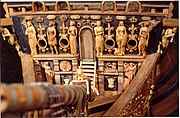HMS Sovereign of the Seas
 'The true portrait of His Majesty's royal ship the Sovereign of the Seas', a contemporaneous engraving by J. Payne
| |
| History | |
|---|---|
| Name | Sovereign of the Seas |
| Builder | Peter Pett, Woolwich Dockyard |
| Launched | 13 October 1637 |
| Renamed |
|
| Fate | Burnt, 1697 |
| Notes |
|
| General characteristics as built[1] | |
| Class and type | 90-gun first-rate ship of the line |
| Tons burthen | 1522 |
| Length | 127 ft (39 m) (keel) |
| Beam | 46 ft 6 in (14.17 m) |
| Depth of hold | 19 ft 4 in (5.89 m) |
| Propulsion | Sails |
| Sail plan | Full-rigged ship |
| Armament |
|
| General characteristics after 1660 rebuild[2] | |
| Class and type | 100-gun first-rate ship of the line |
| Tons burthen | 1605 |
| Length | 127 ft (39 m) (keel) |
| Beam | 47 ft 6 in (14.48 m) |
| Depth of hold | 19 ft 2 in (5.84 m) |
| Propulsion | Sails |
| Sail plan | Full-rigged ship |
| Armament | 100 guns of various weights of shot |
| General characteristics after 1685 rebuild[3] | |
| Class and type | 100-gun first-rate ship of the line |
| Tons burthen | 1683 tons |
| Length | 167 ft 9 in (51.13 m) (gundeck) |
| Beam | 48 ft 4 in (14.73 m) |
| Depth of hold | 19 ft 4 in (5.89 m) |
| Propulsion | Sails |
| Sail plan | Full-rigged ship |
| Armament | 100 guns of various weights of shot |
Sovereign of the Seas was a 17th-century warship of the English Navy. She was ordered as a 90-gun first-rate ship of the line,[1][4] but at launch was armed with 102 bronze guns at the insistence of the king.[4] She was later renamed Sovereign under the republican Commonwealth, and then HMS Royal Sovereign at the Restoration of Charles II.
The elaborately gilded stern ordered by Charles I of England meant enemy ships knew her as the "Golden Devil".[5] She was launched on 13 October 1637, and served from 1638 until 1697, when a fire burnt the ship to the waterline at Chatham.
History

Sovereign of the Seas was ordered in August 1634 on the personal initiative of Charles I of England, as a prestige project. The decision provoked much opposition from the Brethren of Trinity House, who pointed out that "There is no port in the Kingdome that can harbour this ship. The wild sea must be her port, her anchors and cables her safety; if either fail, the ship must perish, the King lose his jewel, four or five hundred man must die, and perhaps some great and noble peer".[6]
These objections were overcome with the help of Admiral
The most extravagantly decorated warship in the Royal Navy, she was adorned from stern to bow with gilded carvings against a black background, designed by
Charles ordered 102 bronze cannon, to ensure it was the most powerfully armed ship in the world; these were made by
In the third ports from the bow, there were two 11-foot (3.4 m) demi-cannon drakes weighing, together, 4.3 tons (4300 kg). Behind them were twenty cannon drakes, nine feet long, and weighing in all 45.7 tons (45700 kg). In the third port from the stern were two more 11-foot (3.4 m) demi-cannon drakes weighing, together, 4.3 tons (4300 kg). The last two ports on either side were occupied by the stern chase – four 10.5-foot (3.2 m) demi-cannon drakes weighing a total of 11.4 tons (11400 kg).
The middle gun deck had heavy fortified culverins – that is, guns short for their bore – fore and aft. There were two 11.5-foot (3.5 m) pieces, weighing 4.8 tons (4800 kg), in the fore chase; four 11.5-foot (3.5 m) pieces, weighing 10.2 tons (10200 kg), in the stern chase. Immediately behind the fore chase were two demi-culverin drakes, eight to nine feet (2.4 to 2.7 m) long, weighing some 1.9 tons (1900 kg). Then came twenty-two 9.5-foot (2.9 m) culverin drakes weighing a total of 30.4 tons (30400 kg).
On the upper gun deck there were two 10-foot (3.0 m) fortified demi-culverins in the fore chase and two in the stern chase, both pairs weighing 2.8 tons (2800 kg). Between them there were twenty-two demi-culverin drakes, eight to nine feet (2.4 to 2.7 m) long, weighing over 21 tons (21000 kg) in total.
There were eight eight-to-nine-foot (2.4 to 2.7 m) demi-culverin drakes weighing 7.7 tons (7700 kg) in the forecastle; another six weighing 5.7 tons (5700 kg) on the half-deck. The quarter-deck carried two six-foot demi-culverin drake cutts – a cutt, again, being a shorter version of a gun – weighing 16 hundredweight (726 kg). Then there were another two six-foot culverin cutts, weighing 1.3 tons (1,179 kg), aft of the forecastle bulkhead. In all, Sovereign of the Seas carried 155.9 tons (141,430 kg) of guns – and that did not include the weight of the gun carriages. Altogether they cost £26,441 13s 6d including £3 per piece to have the Tudor rose, a crown and the motto: Carolvs Edgari sceptrvm aqvarum – "Charles has established Edgar’s sceptre of the waters" – engraved on them. The gun carriages, made by Matthew Banks, Master Carpenter for the Office of Ordinance, cost another £558 11s 8d.
By 1642, her armament had been reduced to 90 guns.
Sovereign of the Seas was not so much built because of tactical considerations, but as a deliberate attempt to bolster the reputation of the English crown. Her name was, in itself, a political statement as Charles tried to revive the perceived ancient right of the English kings to be recognised as the 'lords of the seas.' English ships demanded that other ships strike their flags in salute, even in foreign ports. The Dutch legal thinker
Rear-Admiral Sir

When, during the
She was present at the
She was smaller than
Destruction
Sovereign became leaky and defective with age during the reign of
She ignominiously ended her days, in mid January 1696,
In her honour, naval tradition has kept the name of this ship afloat, and several subsequent ships have been named HMS Royal Sovereign.
In popular culture
A painting from this ship survives on the ceiling of Commissioners House at Chatham Dockyard, over the grand staircase. It depicts an assembly of the gods and depicts Mars being crowned by Neptune, surrounded by the goddesses Hope, Peace, Justice and Plenty. The painting is surrounded by a gilded frieze depicting sea creatures. It is attributed to James Thornhill, the King's Serjeant Painter. He painted the ceilings of the Royal Hospital Greenwich and the Dome of Saint Paul's Cathedral.
Thomas Carew's poem "Upon the Royal Ship called the 'Sovereign of the Seas', built by Peter Pett, Master Builder; His Father, Captain Phineas Pett, Supervisor: 1637" is a paean to the vessel, calling it the eighth wonder of the world:[18]
... Monarchal Ship, whose Fabrick doth outpride
ThePharos, Colosse, Memphique Pyramide...
We yt have heard of Seaven, now see ye Eight
Wonder at home; of Naual art the height...
Neptune is proud o'th burden, and doth wonder
To hear a Fourefold Fire out-roreIouv's Thunder ...
-
Model of Sovereign of the Seas on display in the Bodrum Museum of Underwater Archaeology, Bodrum, Turkey, with royals
-
Stern of Sovereign of the Seas
-
Carvings on Sovereign of the Seas' beakhead bulkhead
See also
- List of world's largest wooden ships
References
- ^ a b c d Lavery, Ships of the Line vol. 1, p. 158.
- ^ a b Lavery, Ships of the Line vol. 1, p. 160.
- ^ a b c Lavery, Ships of the Line vol. 1, p. 163.
- ^ a b c d Royal Navy, Sovereign of the Seas.
- ^ a b Famous Fighters of the Fleet, Edward Fraser, 1904, p.200
- ^ Berckman 1974, p. 79.
- The Embarrassment of Riches, New York, p. 230
- ^ Evelyn Berckman, Creators and Destroyers of the English Navy — as related by the State Papers Domestic, London 1974, p.81
- ^ Rodger, N.A.M. (2004), The Command of the Ocean: A Naval History of Britain 1649–1815, Penguin Group, p. 216
- ^ Age Scheffer, Roemruchte jaren van onze vloot, Baarn 1966, p.21: ingeval sijluyden het schip genaemt de Souverain komen te ruineren
- ^ Angus Konstam, Warships of the Anglo-Dutch Wars 1652–74. Osprey Publishing 2011, p.28
- ^ Rodger, N.A.M. (2004), The Command of the Ocean: A Naval History of Britain 1649–1815, Penguin Group, p. 14
- ^ Rodger, N.A.M. (2004), The Command of the Ocean: A Naval History of Britain 1649–1815, Penguin Group, p. 77
- ^ Rodger, N.A.M. (2004), The Command of the Ocean: A Naval History of Britain 1649–1815, Penguin Group, p. 144
- ^ Age Scheffer, Roemruchte jaren van onze vloot, Baarn 1966, p. 193
- ^ Public Records Office: Secretary's Department of the Admiralty In-Letters 5256
- ^ Famous Fighters of the Fleet, Edward Fraser, 1904, p.201
- JSTOR 2910435.
Sources
- Sovereign of the Seas. Retrieved 22 December 2007.
- Berckman, Evelyn (1974). Creators and Destroyers of the English Navy. Hamish Hamilton. ISBN 978-0241890349.
- Lavery, Brian (2003) The Ship of the Line – Volume 1: The development of the battlefleet 1650–1850. Conway Maritime Press. ISBN 0-85177-252-8.




